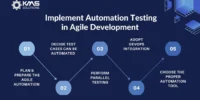Welcome to the next phase of UI architecture evolution – Micro Frontends Makeover 2.0. In the fast-paced world of web development, keeping your user interface (UI) fresh and dynamic is essential. Let’s explore quick tips to revitalize your UI architecture and deliver an enhanced user experience.
1. Modularization Magic: Break It Down Into Micro Frontends
Embrace the magic of modularization by breaking down your UI into micro frontends. Each micro frontend represents a self-contained module, allowing for independent development, deployment, and maintenance. This modular approach enhances flexibility and scalability in your UI architecture.
2. Seamless Integration Symphony: Harmonize Micro Frontends Effortlessly
Orchestrate a seamless integration symphony by harmonizing micro frontends effortlessly. Use lightweight frameworks and communication protocols to facilitate smooth collaboration between micro frontends. Achieving a cohesive user experience across modules is key to a successful UI makeover.
3. Consistent Design Language: The UI Elegance Palette ️
Consider your design language as the palette for UI elegance. Maintain a consistent design language across micro frontends, ensuring a unified and visually appealing experience for users. Consistency in design elements, such as colors, typography, and layout, fosters a sense of coherence.
4. Progressive Loading Prowess: Optimize for Performance
Optimize your UI architecture for performance with progressive loading prowess. Implement lazy loading strategies to load micro frontends on demand, reducing initial page load times. Prioritize the critical rendering path to ensure users quickly access the essential elements of your application.
5. State Management Simplicity: Keep It Agile and Responsive
Keep state management agile and responsive by adopting simplicity. Choose state management solutions that align with the modular nature of micro frontends. This ensures that each module manages its state efficiently while contributing to a coherent overall application state.
6. Cross-Browser Compatibility Ballet: Ensure a Graceful Performance
Perform a ballet of cross-browser compatibility to ensure a graceful UI experience. Test your micro frontends across various browsers and devices, addressing any compatibility issues. A UI makeover is incomplete without guaranteeing a consistent and delightful performance across the digital stage.
7. Accessibility Affluence: Design for All Audiences
Design your UI architecture with affluence in accessibility. Ensure that micro frontends adhere to accessibility standards, making your application inclusive for all audiences. Consider factors such as keyboard navigation, screen reader compatibility, and color contrast to create a universally accessible UI.
8. Continuous Testing Choreography: Refine and Polish Regularly ️
Choreograph a continuous testing routine to refine and polish your UI regularly. Implement automated testing for each micro frontend, ensuring that updates and changes maintain the expected quality. Continuous testing is the secret sauce for an ever-evolving and high-performance UI architecture.
Conclusion: Micro Frontends Makeover Unleashed 2.0
As we embark on the Micro Frontends Makeover 2.0 journey, remember that UI architecture is an evolving masterpiece. From modularization magic to continuous testing choreography, these quick tips are your guide to revitalizing your UI and providing users with a modern, seamless, and delightful experience.








